Who’s camping out in silk tents and eating all the leaves on your trees? It’s probably be the Eastern tent caterpillar.
The Eastern tent caterpillar (Malacosoma americanum) is a native insect in its larval (immature) stage and is easily recognized by it’s silk “tents”. In contrast, you probably don’t notice the adult stage. Adults are moths that arrive in your garden in midsummer, are pretty nondescript looking, and have a short lifespan.
But before their death, female tent caterpillars each lay hundreds of eggs on branches of their preferred host trees. This means the potential for thousands of caterpillars eating your trees the following spring.
How to Recognize the Eastern Tent Caterpillar
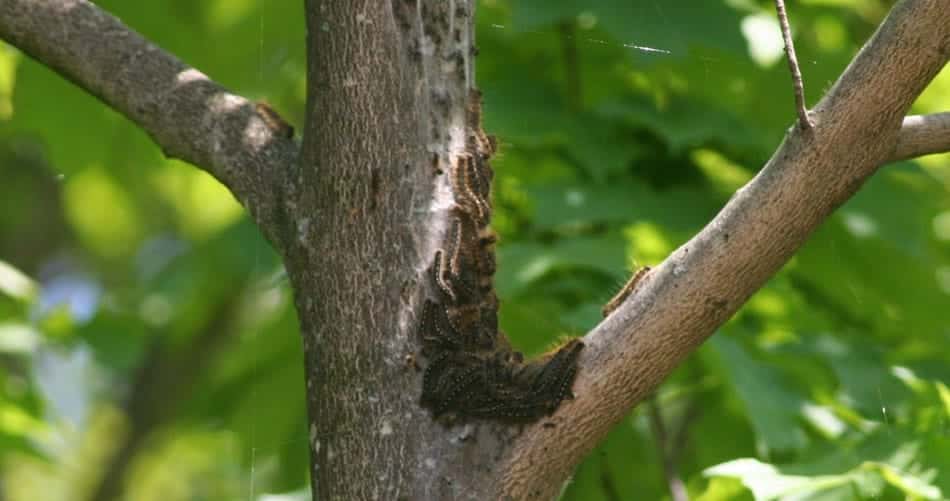 Check For It In The Right Trees
Check For It In The Right Trees
Look for this pest in the trees it most prefers. These are most often apple (Malus) and cherry (Prunus) tree species, including:
- almond,
- apple and crabapple,
- apricot,
- peach,
- pear,
- plum,
- hawthorn,
- wild cherry, and also
- mountain ash (Sorbus).
Look For Egg Masses
In fall and winter, look for eggs on these trees. The egg masses laid by the female moths are small, dark, and have a shiny exterior.
You’ll find them on branches, with the mass enclosing the branch. Because they’re small, you may have to look closely to find them.
These masses stay in place over winter and hatch in spring. View an image of an egg mass here.
Spot Adult Caterpillars
The adult Eastern tent caterpillar is black and hairy. It has white stripes running along its body with narrower brown and yellow lines on the sides, as well as blue spots. When fully grown, it’s about 1.5 to 2 inches long.
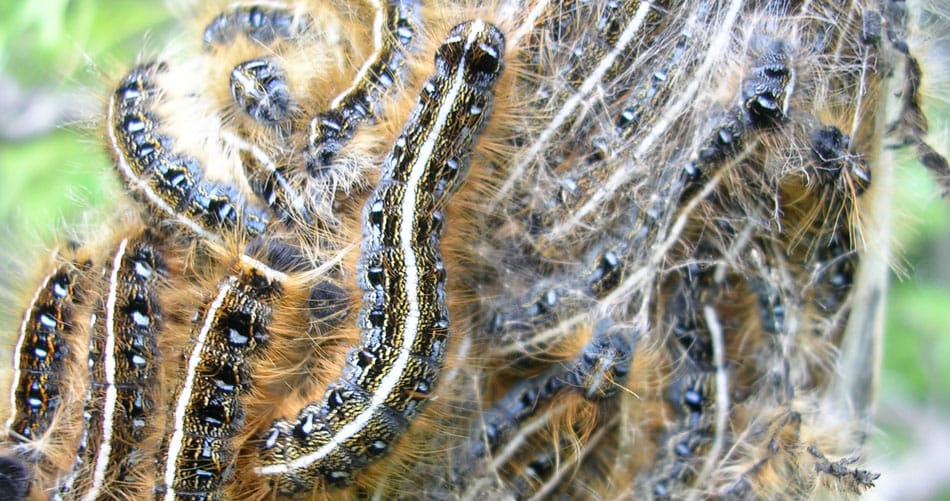
Watch Out For Tents
Eastern tent caterpillars emerge as the host tree is putting out new spring leaf growth. You’ll notice them as they start to make their recognizable “tents” or spun cocoons on branches and in branch crotches.
As the caterpillars begin eating the tree’s buds and leaves and start to grow, they also enlarge their tents.
The caterpillars eat leaves for a month or so and then crawl down the tree in search of a place to spin a solitary cocoon, from which the adult moths emerge in summer to start their life cycle again.
You’ll find the caterpillars crawling across sidewalks, roads, and up buildings in their search for a cocoon site, but at this stage of their life, they are no longer eating any leaves. Instead of squishing them, leave them for their natural predators such as birds, snakes, and raccoons to eat.
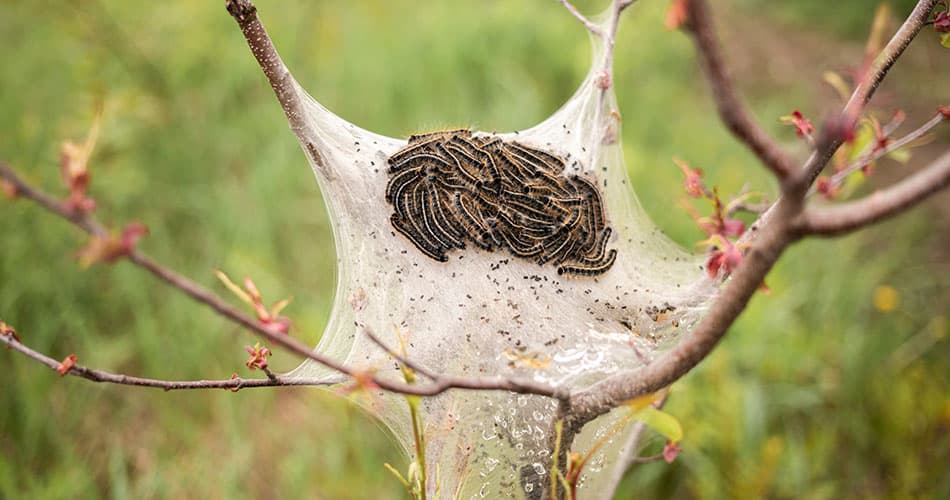
Tree Damage Caused by Eastern Tent Caterpillars
Caterpillars eat the tender, juicy new leaves and buds that trees put out in spring. Depending on the number of caterpillars and the size and condition of your trees, damage can be moderate to severe.
Often, the larvae eat all the leaves on a tree. Usually, this damage is primarily an aesthetic issue. This degree of caterpillar damage usually only weakens the tree after three or more years of more than 50% defoliation. Because populations of this pest rise and fall, you’re unlikely to have three years of severe defoliation in a row.
3 Options for Dealing With Tent Caterpillars
What you do to control or remove Eastern tent caterpillars from your trees is dependent on your level of comfort.
Option 1 – Leave them Alone
Doing nothing is often a wise choice if your trees are healthy and the caterpillar population is not overwhelming. After a month or so of causing spring leaf damage, the caterpillars will stop feeding. Your trees will continue through their growing cycle, generally without serious damage to their overall health.
Because the annual populations of tent caterpillars fluctuate, you may have several years of low populations and minimal leaf damage.
Option 2 – Remove & Dispose of Them
If you can’t leave them in place, the easiest ways to get rid of either egg masses or spun tents are to remove them by hand or to prune out affected branches.
Removing egg masses is easiest in winter, when the branches of deciduous host trees are bare. Simply scrape them off the tree and burn them or soak them in soapy water to kill the eggs.
You can remove tents when you see them in spring. It’s easy to do this by hand or with long-handled garden tools. Even a broom will work.
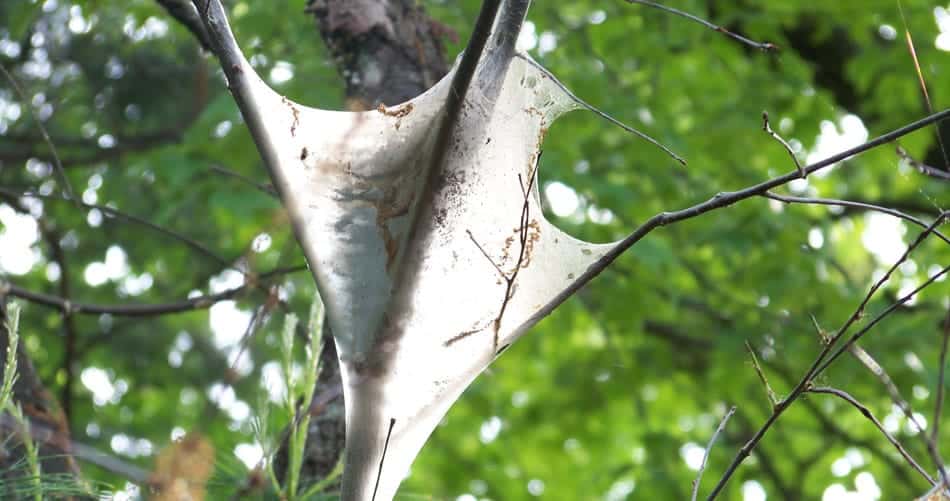
You have options for what to do if you spot Eastern tent caterpillars in your tree
Dispose of the branches, eggs, and caterpillars right away. If you’ve removed the nest by hand, simply drop it into a bucket of soapy water. If you’ve pruned out the tent, we recommend cutting the branches into smaller pieces and putting everything in a closed paper or plastic bag in the trash. Without access to light and food, the larvae won’t survive. And when eggs hatch there will be nowhere for the larvae to go.
NOTE: If you’re squeamish about handling either eggs or caterpillars, pruning is the better option. But don’t want to prune out large, useful branches just to avoid touching the insects. Pruning out too many branches stresses a tree, especially in warm spring weather when a tree is already using a lot of energy to make leaves and flowers.
Remember too that pruning cuts made in spring are susceptible to other insects and diseases that have also emerged from dormancy.
Option 3 – Spray With Insecticide
Another method of control is to spray the tree with insecticide. This can reduce the population that can reproduce, thereby reducing the following year’s caterpillar population.
Spraying works if it’s done correctly, and at the right time. Non-toxic sprays, in particular, must be applied at the right stage of an insect’s life and at a time when sprays won’t damage other insects.
For Eastern tent caterpillars, a targeted insecticide is best applied when they’re concentrated in their nests – usually in May.
Bacillus thuringiensis (B.t.) is the most environmentally sound organic control method but it must be applied in May to be effective.
Remember that traditional neurotoxic pesticides must make contact with the pest to be effective, but they won’t reach the larvae inside their protective tents. However, these chemicals will kill other beneficial insects that you do want in your garden. Among the beneficial insects you want are the several types of parasitic wasps that naturally kill tent caterpillars.
What NOT to Do!
DO NOT use fire to burn out the caterpillar webs. A flame torch may be satisfying, but you will only damage your tree by burning the bark. And in dry conditions, flaming tents and leaves can spread fire to surrounding areas.
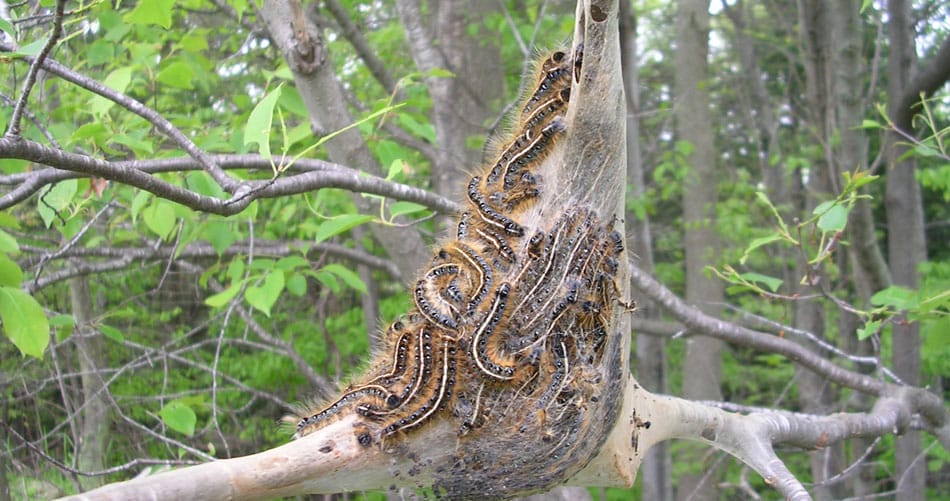 What to Do If Your Tree Has Been Defoliated
What to Do If Your Tree Has Been Defoliated
If your trees have been defoliated by the Eastern tent caterpillar, we recommend that you water them regularly and apply an organic fertilizer. This will reduce stress on the trees and give them a better chance to recover quickly.
We Can Help
Our Plant Health Care program (PHC) addresses pests and diseases through organic means. We can monitor and treat your shrubs and trees throughout the year to keep tent caterpillars and other pests in check while ensuring that the beneficial pollinators and predatory insects you do want remain.
If you’d like us to inspect your trees for Eastern tent caterpillar or recommend a PHC program, please give us a call at 908-309-6611.
GET THE LATEST NEWS
Subscribe to the Organic Plant Care Newsletter and get timely and helpful tips and updates monthly.
There's no spam - we promise!





